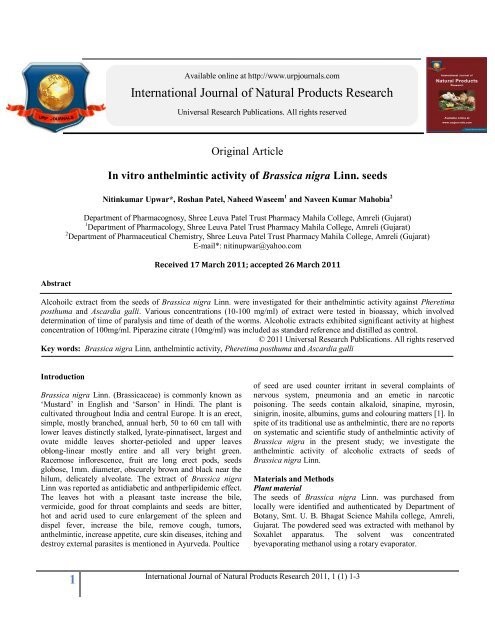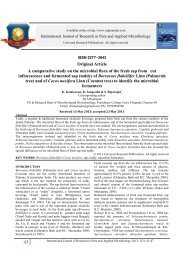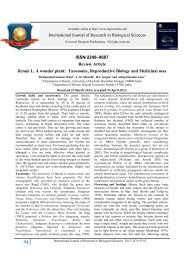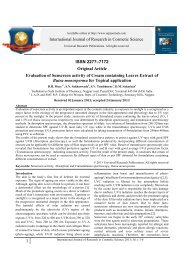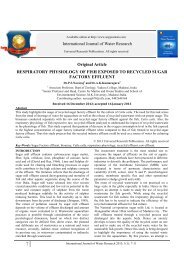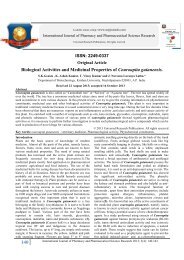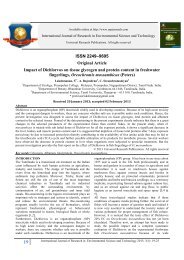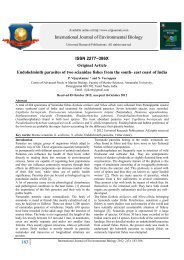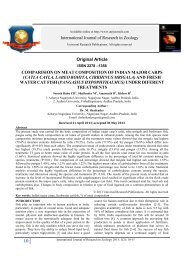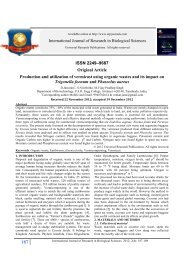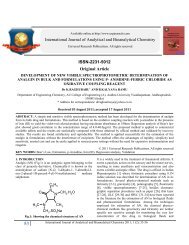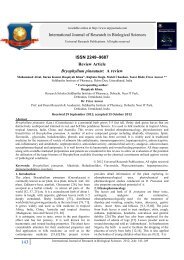In vitro anthelmintic activity of Brassica nigra Linn ... - URP Journals
In vitro anthelmintic activity of Brassica nigra Linn ... - URP Journals
In vitro anthelmintic activity of Brassica nigra Linn ... - URP Journals
You also want an ePaper? Increase the reach of your titles
YUMPU automatically turns print PDFs into web optimized ePapers that Google loves.
Available online at http://www.urpjournals.com<br />
<strong>In</strong>ternational Journal <strong>of</strong> Natural Products Research<br />
Universal Research Publications. All rights reserved<br />
Original Article<br />
<strong>In</strong> <strong>vitro</strong> <strong>anthelmintic</strong> <strong>activity</strong> <strong>of</strong> <strong>Brassica</strong> <strong>nigra</strong> <strong>Linn</strong>. seeds<br />
Abstract<br />
Nitinkumar Upwar*, Roshan Patel, Naheed Waseem 1 and Naveen Kumar Mahobia 2<br />
Department <strong>of</strong> Pharmacognosy, Shree Leuva Patel Trust Pharmacy Mahila College, Amreli (Gujarat)<br />
1 Department <strong>of</strong> Pharmacology, Shree Leuva Patel Trust Pharmacy Mahila College, Amreli (Gujarat)<br />
2 Department <strong>of</strong> Pharmaceutical Chemistry, Shree Leuva Patel Trust Pharmacy Mahila College, Amreli (Gujarat)<br />
E-mail*: nitinupwar@yahoo.com<br />
Received 17 March 2011; accepted 26 March 2011<br />
Alcohoilc extract from the seeds <strong>of</strong> <strong>Brassica</strong> <strong>nigra</strong> <strong>Linn</strong>. were investigated for their <strong>anthelmintic</strong> <strong>activity</strong> against Pheretima<br />
posthuma and Ascardia galli. Various concentrations (10-100 mg/ml) <strong>of</strong> extract were tested in bioassay, which involved<br />
determination <strong>of</strong> time <strong>of</strong> paralysis and time <strong>of</strong> death <strong>of</strong> the worms. Alcoholic extracts exhibited significant <strong>activity</strong> at highest<br />
concentration <strong>of</strong> 100mg/ml. Piperazine citrate (10mg/ml) was included as standard reference and distilled as control.<br />
© 2011 Universal Research Publications. All rights reserved<br />
Key words: <strong>Brassica</strong> <strong>nigra</strong> <strong>Linn</strong>, <strong>anthelmintic</strong> <strong>activity</strong>, Pheretima posthuma and Ascardia galli<br />
<strong>In</strong>troduction<br />
<strong>Brassica</strong> <strong>nigra</strong> <strong>Linn</strong>. (<strong>Brassica</strong>ceae) is commonly known as<br />
‘Mustard’ in English and ‘Sarson’ in Hindi. The plant is<br />
cultivated throughout <strong>In</strong>dia and central Europe. It is an erect,<br />
simple, mostly branched, annual herb, 50 to 60 cm tall with<br />
lower leaves distinctly stalked, lyrate-pinnatisect, largest and<br />
ovate middle leaves shorter-petioled and upper leaves<br />
oblong-linear mostly entire and all very bright green.<br />
Racemose inflorescence, fruit are long erect pods, seeds<br />
globose, 1mm. diameter, obscurely brown and black near the<br />
hilum, delicately alveolate. The extract <strong>of</strong> <strong>Brassica</strong> <strong>nigra</strong><br />
<strong>Linn</strong> was reported as antidiabetic and anthperlipidemic effect.<br />
The leaves hot with a pleasant taste increase the bile,<br />
vermicide, good for throat complaints and seeds are bitter,<br />
hot and acrid used to cure enlargement <strong>of</strong> the spleen and<br />
dispel fever, increase the bile, remove cough, tumors,<br />
<strong>anthelmintic</strong>, increase appetite, cure skin diseases, itching and<br />
destroy external parasites is mentioned in Ayurveda. Poultice<br />
<strong>of</strong> seed are used counter irritant in several complaints <strong>of</strong><br />
nervous system, pneumonia and an emetic in narcotic<br />
poisoning. The seeds contain alkaloid, sinapine, myrosin,<br />
sinigrin, inosite, albumins, gums and colouring matters [1]. <strong>In</strong><br />
spite <strong>of</strong> its traditional use as <strong>anthelmintic</strong>, there are no reports<br />
on systematic and scientific study <strong>of</strong> <strong>anthelmintic</strong> <strong>activity</strong> <strong>of</strong><br />
<strong>Brassica</strong> <strong>nigra</strong> in the present study; we investigate the<br />
<strong>anthelmintic</strong> <strong>activity</strong> <strong>of</strong> alcoholic extracts <strong>of</strong> seeds <strong>of</strong><br />
<strong>Brassica</strong> <strong>nigra</strong> <strong>Linn</strong>.<br />
Materials and Methods<br />
Plant material<br />
The seeds <strong>of</strong> <strong>Brassica</strong> <strong>nigra</strong> <strong>Linn</strong>. was purchased from<br />
locally were identified and authenticated by Department <strong>of</strong><br />
Botany, Smt. U. B. Bhagat Science Mahila college, Amreli,<br />
Gujarat. The powdered seed was extracted with methanol by<br />
Soxahlet apparatus. The solvent was concentrated<br />
byevaporating methanol using a rotary evaporator.<br />
1<br />
<strong>In</strong>ternational Journal <strong>of</strong> Natural Products Research 2011, 1 (1) 1-3
Table 1: Anthelmintic <strong>activity</strong> <strong>of</strong> alcoholic extract <strong>of</strong> <strong>Brassica</strong> <strong>nigra</strong> <strong>Linn</strong>.<br />
Time taken for paralysis (P) and death (D) <strong>of</strong> worms (mins)<br />
Concentration<br />
Test<br />
P. posthuma A. galli<br />
(mg/ml)<br />
P D P D<br />
Control - - - - -<br />
Alcohol<br />
extracts<br />
Piperazine<br />
citrate<br />
10 24.40 ± 0.4 64.17 ± 0.5 16.50 ± 0.5 43.54 ± 0.5<br />
50 17.26 ± 0.1 44.64 ± 0.4 10.51 ± 0.7 24.61 ± 0.4<br />
100 8.15 ± 0.2 27.45 ± 0.3 7.94 ± 0.4 16.09 ± 0.8<br />
10 20.37 ± 0.3 51.35± 0.1 12.05 ± 0.91 40.41 ± 0.3<br />
Results are expressed as Mean ± SEM from six observations<br />
Preparation <strong>of</strong> extracts<br />
The seeds <strong>of</strong> <strong>Brassica</strong> <strong>nigra</strong> <strong>Linn</strong>. cleaned and coarsely<br />
powder. It was then passed through the 40 mesh sieve. A<br />
weighted quantity (200 gm) <strong>of</strong> the power was subjected to<br />
continuous hot extraction in Soxhlet Apparatus exhaustively.<br />
The extract was evaporated under pressure using rotary<br />
evaporator until all solvent has been removed to give an<br />
extract sample. Percentage yield <strong>of</strong> methanol extract 4.3%<br />
w/w. The dry extracts obtained were subjected to various<br />
chemical tests to detect the presence <strong>of</strong> different<br />
phytoconstituents [2,3].<br />
Animals<br />
<strong>In</strong>dian adult earth worm (Pheretima posthuma) was collected<br />
from water logged areas <strong>of</strong> Amreli and Ascardia galli<br />
(nematode) worm were obtained from freshly slaughtered<br />
fowls. Both worm types were identified at the Department <strong>of</strong><br />
Zoology, Smt. U. B. Bhagat Science Mahila college, Amreli,<br />
Gujarat, <strong>In</strong>dia.<br />
Drugs and chemicals used<br />
Piperazine citrate (Noel, Mumbai) were used as reference<br />
standards. Chemicals: Methanol (95% v/v) (Rexol Ec<strong>of</strong>uels<br />
P. Ltd. Mumbai).<br />
Evaluation <strong>of</strong> <strong>anthelmintic</strong> <strong>activity</strong><br />
The assay was performed on <strong>In</strong>dian earthworm Pheritima<br />
posthuma due to its anatomical and physiological<br />
resemblance with intestinal roundworm parasite <strong>of</strong> human<br />
beings [4-8]. Because <strong>of</strong> easy availability, has been used<br />
widely for the initial evaluation <strong>anthelmintic</strong> compounds in<br />
<strong>vitro</strong> [9-13]. Ascardia galli worms are easily available in<br />
plenty from freshly slaughtered flows and their use, as<br />
suitable model for screening <strong>of</strong> <strong>anthelmintic</strong> drug was<br />
advocated as earlier [14-16]. Six groups <strong>of</strong> worms were used<br />
to assess the <strong>anthelmintic</strong> properties <strong>of</strong> alcoholic extracts <strong>of</strong><br />
<strong>Brassica</strong> <strong>nigra</strong> <strong>Linn</strong>. seeds. Groups 1 were the control worms<br />
placed in distilled water; groups 2-4 were treated with 10, 50<br />
and 100 mg/ml <strong>of</strong> methanolic extracts <strong>Brassica</strong> <strong>nigra</strong> <strong>Linn</strong>. <strong>In</strong><br />
distilled water; group 5 with Piperazine citrate (10mg/ml) in<br />
distilled water. Each group included six worms <strong>of</strong> each type.<br />
Observations were made for the time taken to set paralysis<br />
and death <strong>of</strong> the individual worms. Mean time for the<br />
paralysis (P) in min. was noted when no movement <strong>of</strong> any<br />
sort could be observed, except when the worm was shaken<br />
vigorously; time <strong>of</strong> death (D) in min. was recorded after<br />
ascertaining the worms neither moved when shaken<br />
vigorously nor when dipped in warm water (50°C).<br />
Piperazine citrate (10 mg/ml) was included as reference<br />
compound [17].<br />
Results<br />
Preliminary phytochemical screening <strong>of</strong> alcoholic extract<br />
revealed presence <strong>of</strong> glycosides and alkaloids. As shown in<br />
Table 1, the alcoholic extract <strong>of</strong> seeds <strong>of</strong> <strong>Brassica</strong> <strong>nigra</strong> <strong>Linn</strong>.<br />
Displayed significant <strong>anthelmintic</strong> properties at higher<br />
concentration. Alcoholic extract showed <strong>anthelmintic</strong><br />
activities in dose dependant manner giving shortest <strong>of</strong> time <strong>of</strong><br />
paralysis (P) and death (D) with 100 mg/ml concentration for<br />
both type worms. The alcoholic extract <strong>of</strong> seeds <strong>of</strong> <strong>Brassica</strong><br />
<strong>nigra</strong> <strong>Linn</strong>. Caused paralysis in 8.15 min and death in 27.45<br />
min against the earthworm Pheretima posthuma. The<br />
reference drug piperazine citrate showed same at 21 min and<br />
59 min.<br />
Ascardia galli worms also showed sensitivity to the alcoholic<br />
extracts <strong>of</strong> <strong>Brassica</strong> <strong>nigra</strong> <strong>Linn</strong>. The alcoholic extract caused<br />
paralysis in 5 min, and death in 29 min at higher<br />
concentration <strong>of</strong> 100mg/ml. Piperazine citrate did same at 12<br />
and 41min.<br />
2<br />
<strong>In</strong>ternational Journal <strong>of</strong> Natural Products Research 2011, 1 (1) 1-3
Discussion<br />
<strong>In</strong> this study, <strong>anthelmintic</strong> assay was performed on adult<br />
<strong>In</strong>dian earthworm, Pheretima posthuma due to its anatomical<br />
and physiological resemblance with the intestinal roundworm<br />
parasite <strong>of</strong> human beings [5-8]. Because <strong>of</strong> easy availability,<br />
earthworms have been used widely for the initial evaluation<br />
<strong>of</strong> <strong>anthelmintic</strong> compounds in <strong>vitro</strong> [18-19]. Ascardia galli<br />
worms are easily available in plenty from freshly slaughtered<br />
fowls and their use, as a suitable model for screening <strong>of</strong><br />
<strong>anthelmintic</strong> drug was advocated earlier [14-16]. Piperazine<br />
citrate causes flaccid paralysis <strong>of</strong> worms that resulting<br />
expulsion <strong>of</strong> worms by peristalsis. Piperazine citrate has<br />
causes death <strong>of</strong> the parasite. Therefore, it is concluded that<br />
alcoholic extracts <strong>of</strong> <strong>Brassica</strong> <strong>nigra</strong> <strong>Linn</strong>. Seeds have potent<br />
<strong>anthelmintic</strong> <strong>activity</strong> when compared the conventionally used<br />
drug and is equipotent to standard <strong>anthelmintic</strong> drug tested<br />
against worm species. It justifies its Ayurvedic use in curing<br />
helmintic infections.<br />
References<br />
[1] K.R. Kirtikar, B.D. Basu, <strong>In</strong>dian Medicinal Plants, Vol. I,<br />
Second ed., <strong>In</strong>ternational Book Distributors, Dehradun, <strong>In</strong>dia,<br />
1984, pp. 168-169.<br />
[2] J.B. Harbone, Phytochemical methods: A guide for<br />
modern techniques <strong>of</strong> plant analysis, Chapmann and Hall,<br />
London, 1998.<br />
[3] C.K. Kokate, Practical Pharmacognosy, Third ed.,<br />
Vallabh Prakashan, New Delhi, 1994.<br />
[4] E.O. Ajaiyeoba, P.A. Onocha, O.T. Olarenwaju, <strong>In</strong> <strong>vitro</strong><br />
<strong>anthelmintic</strong> properties <strong>of</strong> Buchholzia coriaceae and<br />
Gynandropsis gynandra extract, Pharm. Biol. 39 (2001) 217-<br />
220.<br />
[5] G.W. Thorn, R.D. Adams, E. Braunwald, K.J.<br />
Isselbacher, R.G. Petersdorf, Harrison’s Principle <strong>of</strong> internal<br />
medicine, McGraw Hill Co., New York, 1977.<br />
[6] R.D. Vidyarthi, A Textbook <strong>of</strong> Zoology, S. Chand Co.,<br />
New Delhi, 1967.<br />
[7] Z. Vigar, Atlas <strong>of</strong> Medical Parasitology, P. Publishing<br />
House, Singapore, 1984.<br />
[8] K.D. Chatterjee, Parasitology, protozoology and<br />
helminthology, Sree Saraswati Press Ltd., Calcutta, 1967.<br />
[9] T. Sollmann, Anthemintics: Their efficiency as tested on<br />
Earthworms, J. Pharmco. Exp. Ther. 12 (1918) 129-70.<br />
[10] G.K. Dash, P. Suresh, D.M. Kar, S. Ganpaty, S.B.<br />
Panda, Evaluation <strong>of</strong> Evolvulus alsinoids <strong>Linn</strong>. for<br />
<strong>anthelmintic</strong> and antimicrobial activities, J. Nat. Rem. 2<br />
(2002) 182-185.<br />
[11] M.L. Jain, S.R. Jain, Therapeutic utility <strong>of</strong> Ocimum<br />
basilicum var. album, Planta Med. 22 (1972) 66-70.<br />
[12] V.D. Szewezuk, E.R. Mongelli, A.B. Pomilio,<br />
Antiparasitic <strong>activity</strong> <strong>of</strong> Melia azadirach growing in<br />
Argentina, Molecular Med. Chem. 1 (2003) 54-57.<br />
[13] Manoj Aswar, Urmila Aswar, Bhagyashri Watkar,<br />
Meenakshi Vays, Akshaya Wagh, Kishore N. Gujar,<br />
Anthelmintic <strong>activity</strong> <strong>of</strong> Ficus benghalensis, <strong>In</strong>ternational J.<br />
Green Pharm. 3 (2008) 170-172.<br />
[14] R.K. Kaushik, J.C. Katiyar, A.B. Sen, Studies on mode<br />
<strong>of</strong> action <strong>of</strong> <strong>anthelmintic</strong>s with Ascardia galli as a test<br />
parasite, <strong>In</strong>dian J. Med. Res. 62 (1974) 1367-75.<br />
[15] J. Lal, S. Chandra, V. Raviprakash, M. Sabir, <strong>In</strong> <strong>vitro</strong><br />
<strong>anthelmintic</strong> action <strong>of</strong> some indigenous medicinal plants on<br />
Ascardia galli worms, <strong>In</strong>dian J. Physiol. Pharmacol. 20<br />
(1976) 64-68.<br />
[16] V. Tandon, P. Pal, B. Roy, H.S.P. Rao, K.S. Reddy, <strong>In</strong><br />
<strong>vitro</strong> <strong>anthelmintic</strong> <strong>activity</strong> <strong>of</strong> root tuber extract <strong>of</strong> Flemingia<br />
vestita, an indigenous plant in Shillong, <strong>In</strong>dia, Parasitol. Res.<br />
83 (1997) 492-498.<br />
[17] H.K. Sundeep Kumar, Anindya Bose, Arundhuti Raut,<br />
Sujit Kumar Sahu. M.B.V. Raju, Evaluation <strong>of</strong> Anthelmintic<br />
Activity <strong>of</strong> Pistia stratiotes <strong>Linn</strong>., Journal <strong>of</strong> Basic and<br />
Clinical Pharmacy. 1 (2010) 103-105.<br />
[18] R.G. Mali, R.R. Wadekar, <strong>In</strong> Vitro <strong>anthelmintic</strong> <strong>activity</strong><br />
<strong>of</strong> Baliospermum montanum Muell, <strong>In</strong>dian J. Pham. Sci. 70<br />
(2008) 131-133.<br />
[19] S.B. Kosalge, R.A. Fursule, <strong>In</strong>vestigation <strong>of</strong> in <strong>vitro</strong><br />
<strong>anthelmintic</strong> <strong>activity</strong> <strong>of</strong> Thespesia lampas (Cav.), Asian<br />
Journal <strong>of</strong> Pharmaceutical and Clinical Research. 2 (2009)<br />
69-71.<br />
Source <strong>of</strong> support: Nil; Conflict <strong>of</strong> interest: None declared<br />
3<br />
<strong>In</strong>ternational Journal <strong>of</strong> Natural Products Research 2011, 1 (1) 1-3


